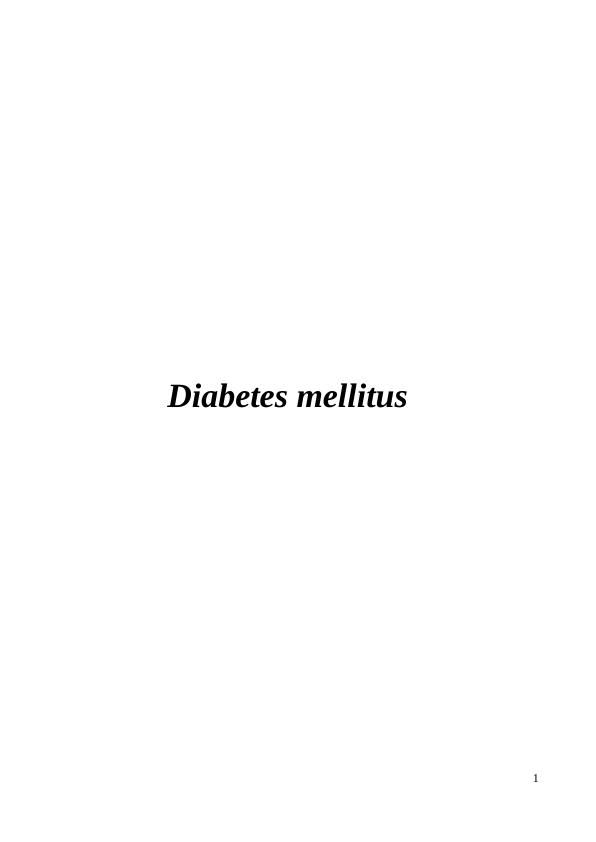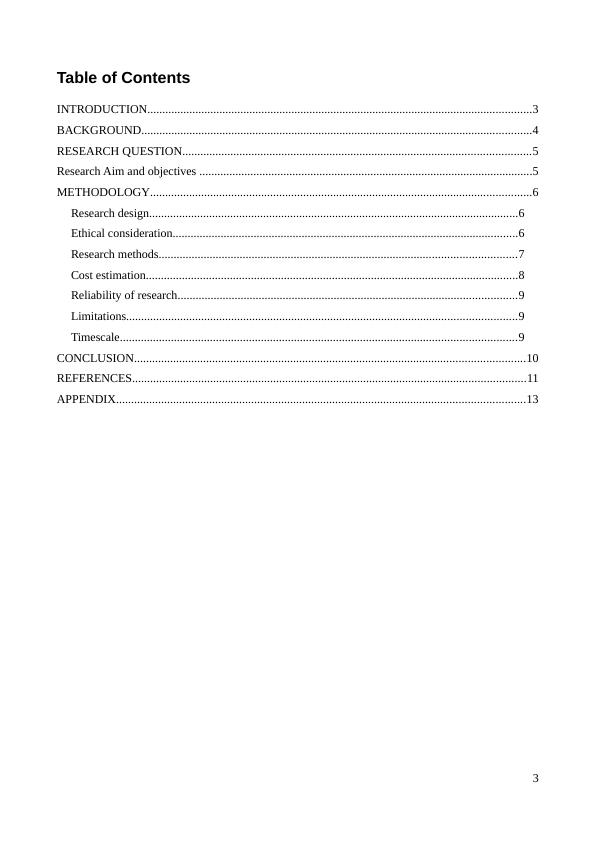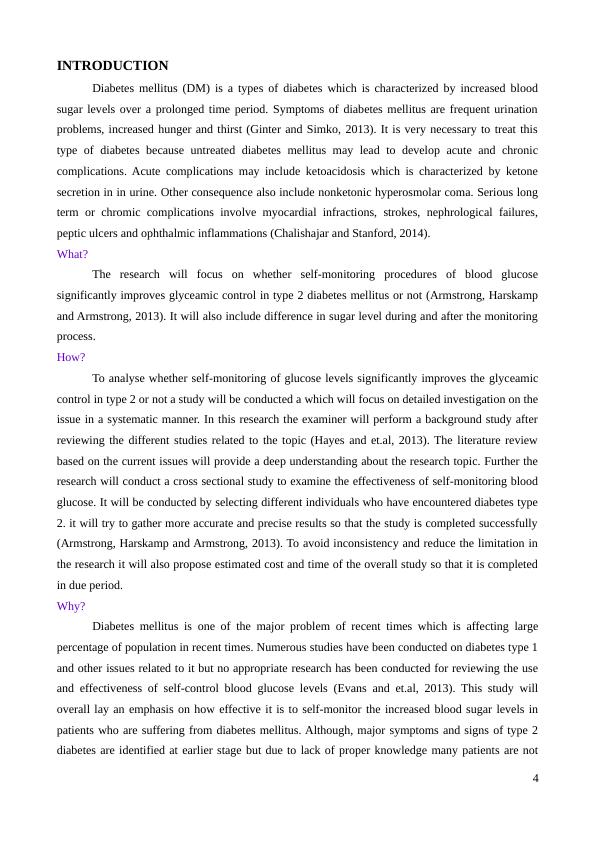Introduction to Diabetes Mellitus (DM)
Identify a researchable question in the field of practice, provide a rationale for its relevance and importance, critique relevant literature, propose a methodological approach and discuss how the new evidence would inform theory and practice.
15 Pages4791 Words178 Views
Added on 2020-01-23
Introduction to Diabetes Mellitus (DM)
Identify a researchable question in the field of practice, provide a rationale for its relevance and importance, critique relevant literature, propose a methodological approach and discuss how the new evidence would inform theory and practice.
Added on 2020-01-23
ShareRelated Documents
Diabetes mellitus1

ABSTRACTDiabetes mellitus is defined as the increase in blood sugar level over a prolonged period oftime. The signs and symptoms of types 2 diabetes are characterized by frequent urination issuesincrease in thirst and hunger level. Aim: The research proposal has mainly focussed on the self monitoring of blood glucose in order toimprove the glycaemic levels in blood. Further the proposal has proposed the comparison ofindividuals who are using self-monitoring techniques with the people who are not using thismethod. The research proposal has also proposed effective strategies to lower down the bloodglucose levels in people suffering from severe diabetes. Methods and design Descriptive research design has been proposed in the study because it will help in understanding theresearch in effective manner. Positivism research paradigms has been projected in the design so thataims and objectives of the research are appropriately framed. The overall research method be basedon primary research method as participants are selected for further analysis.Data analysis For data analysis the proposal has suggested thematic analysis so that presentation in theform of themes, graphs and charts are easily able to interpret the given information and data. Inevery study or research there are many limitation present which affect the quality of proposed study.It can be time limitation, cost limitations and resources limitations. Validity and reliability Validity and reliability in overall research has also been maintained so that the study is performed inan effective manner. In order to eliminate all the types of time and finance limitations the proposalhas proposed to develop various strategies which can effectively reduce the cost and allocate theresource appropriately so that research is conducted successfully. ConclusionThe conclusion to research proposal stated that there was no significant change in glycaemic levelseven after using self-monitoring blood glucose techniques.2

Table of ContentsINTRODUCTION................................................................................................................................3BACKGROUND..................................................................................................................................4RESEARCH QUESTION....................................................................................................................5Research Aim and objectives ...............................................................................................................5METHODOLOGY...............................................................................................................................6Research design...........................................................................................................................6Ethical consideration...................................................................................................................6Research methods.......................................................................................................................7Cost estimation............................................................................................................................8Reliability of research.................................................................................................................9Limitations..................................................................................................................................9Timescale....................................................................................................................................9CONCLUSION..................................................................................................................................10REFERENCES...................................................................................................................................11APPENDIX........................................................................................................................................133

INTRODUCTIONDiabetes mellitus (DM) is a types of diabetes which is characterized by increased bloodsugar levels over a prolonged time period. Symptoms of diabetes mellitus are frequent urinationproblems, increased hunger and thirst (Ginter and Simko, 2013). It is very necessary to treat thistype of diabetes because untreated diabetes mellitus may lead to develop acute and chroniccomplications. Acute complications may include ketoacidosis which is characterized by ketonesecretion in in urine. Other consequence also include nonketonic hyperosmolar coma. Serious longterm or chromic complications involve myocardial infractions, strokes, nephrological failures,peptic ulcers and ophthalmic inflammations (Chalishajar and Stanford, 2014).What?The research will focus on whether self-monitoring procedures of blood glucosesignificantly improves glyceamic control in type 2 diabetes mellitus or not (Armstrong, Harskampand Armstrong, 2013). It will also include difference in sugar level during and after the monitoringprocess.How?To analyse whether self-monitoring of glucose levels significantly improves the glyceamiccontrol in type 2 or not a study will be conducted a which will focus on detailed investigation on theissue in a systematic manner. In this research the examiner will perform a background study afterreviewing the different studies related to the topic (Hayes and et.al, 2013). The literature reviewbased on the current issues will provide a deep understanding about the research topic. Further theresearch will conduct a cross sectional study to examine the effectiveness of self-monitoring bloodglucose. It will be conducted by selecting different individuals who have encountered diabetes type2. it will try to gather more accurate and precise results so that the study is completed successfully(Armstrong, Harskamp and Armstrong, 2013). To avoid inconsistency and reduce the limitation inthe research it will also propose estimated cost and time of the overall study so that it is completedin due period.Why?Diabetes mellitus is one of the major problem of recent times which is affecting largepercentage of population in recent times. Numerous studies have been conducted on diabetes type 1and other issues related to it but no appropriate research has been conducted for reviewing the useand effectiveness of self-control blood glucose levels (Evans and et.al, 2013). This study willoverall lay an emphasis on how effective it is to self-monitor the increased blood sugar levels inpatients who are suffering from diabetes mellitus. Although, major symptoms and signs of type 2diabetes are identified at earlier stage but due to lack of proper knowledge many patients are not4

End of preview
Want to access all the pages? Upload your documents or become a member.
Related Documents
Diabetes Mellitus: Self Monitoring of Blood Glucoselg...
|10
|1148
|242
Assignment on Diabetes Mellituslg...
|8
|2896
|212
Diabetes: Types, Symptoms, Meals, Sugar Alcohols, and Studieslg...
|5
|989
|59
Contemporary Issues of Diabetes Assignmentlg...
|13
|4184
|127
Management of Diabetes Assignment 2022lg...
|11
|3573
|27
Diabetes Mellitus: Types, Diagnosis, and Managementlg...
|5
|1131
|433
